Best Gravel Patio Ideas: DIY Design & Materials

Welcome to our gallery featuring the best gravel patio ideas. A gravel patio is an excellent addition to any home not only because of the added beauty it gives but also because of the multiple purposes it can offer. It can easily transform your backyard into an extension of your living room space, a place to dine and bond with the family, to enjoy a grill out with friends, or a personal sanctuary to enjoy a book or relax after a long tiring day.
Among the available materials in the market, pebbles are one of the most desired ground covers for patios. It is well loved because of the numerous advantages it gives. If looking for a more practical solution and alternative to an expensive stone patio, wooden deck, or interlocking brick pavement, pea pebble is your best option. Design it however, you want, either alone or mixed with other types of stone aggregates or incorporated in your landscape setting. Since it also offers ease of installation, making your own pebble patio can be one of your next “DIY” projects.
Gravel Landscape Patio Pros and Cons
Here are some of the benefits of having a gravel patio:
Requires little maintenance. Gravel patios do not become muddy during rain.
Cost effective. Aggregate is cheaper than other filling materials available in the market. Aggregate usually costs around $35 to $55 per cubic yard and is less expensive than concrete and large stones.
Improves drainage. Aggregate drains quickly. When rainwater runs over a pebble patio, it just soaks into it rather than accumulating. Unlike other filling materials that have to be placed in a slight incline so that rainwater does not run off, pebble may be placed as is in a patio.
Controls erosion. Gravel and stones prevent soil from eroding by holding it in place.
Easier to compact than other fillers. Unlike many landscape material options, it’s easy to work with.
Prevents weed growth. Unwanted weeds are not able to grow out of gravel. Ideally, gravel must be laid at least 4 inches thick from the ground to prevent weeds from growing into your patio.
Keeps rodents away from your garden. Rodents are not able to dig through a bed of gravel unlike soil.
Easy to walk on. Pea pebble particularly has smooth rounded edges compared to larger stones which sometimes have jagged edges. It does not cause discomfort even when walked on barefoot. Since it is a softer surface to walk on, it is more bearable rather than walking on coarse large rocks.
Easy to install. pebble patios require little effort and skills to install. Even if you do not have any previous experience for such, gravel can be laid out without any trouble.
Aesthetically pleasing. Pebbles allow for more creativity in terms of design. It can be easily mixed with other stones or landscaping materials to add beauty to a landscape, garden or patio.
Beneficial to plants. When aggregates are used with plants or in a garden bed along your patio, gravel traps moisture thus reflecting heat better. It is a great alternative to wood mulch as a soil covering.
Improves the value of your home. A gravel patio is a stunning addition to any garden which improves the value of your home at a low cost. It is a wise practical investment that can give a lot of benefits in the long run compared to other filling materials.
Lasts multiple seasons. Aggregate patios can withstand any climate or weather including storms or snow. A layer of snow in a gravel patio may be easily removed with the use of a snow blower, a shovel, or salt. It also works well for warm climates as it does not require watering.
Gravel patios last a long time. Gravel does not decompose and will last years.
Here are some of the cons of having a gravel patio:
Relocating. If you plan on changing the location of your gravel patio, it is a task that is hard to manage. Since it is made up of loose stones, everything needs to be collected and transported carefully from one place to another.
Hazard to children or pets. Small pieces of stones in a gravel patio may be a potential choking hazard for pets or toddlers. Be extra careful if you have young kids or pets at home.
Cannot be used for high traffic areas. Loose stones in a gravel patio can easily lodge into shoe soles. Small stones such as pea gravel is not advisable to be used in walkways used by many people.
Gravel can be easily transferred or scattered to other areas of the yard or home. Be sure to use an edging or border for your patio to prevent it from spreading.
Requires repeated raking to smoothen the path. Heavy footmarks cause dips in the aggregate and can sometimes shift the small stones from their intended place. Prevent this by putting a base layer of rocks in your patio before laying out the gravel.
Needs a base layer – If putting furniture in your gravel patio, it requires an added base.
Must be refreshed – In some cases, gravel needs to be replenished in 3 to 4 years as it starts to soak into the soil. Installation around fences or borders can help alleviate some loss.

This Asian style backyard deck has a harmonious ambiance with its black pea gravel and minimalist furniture and decor.
What Is Pea Gravel?
Pea gravel are small stones found near bodies of water and is characterized by their smooth texture. Its name was derived from its size which resembles a green pea, usually ⅛ inch to ⅜ inches in diameter. Its colors are usually white, beige, shades of gray, rust, brown, red, blue or translucent.
It is usually used for landscaping or gardening and its common applications are patios, pathways, driveways, playgrounds, paver fillers or as mulch material around plant containers.
A pea gravel patio is a treatment for an outdoor space or paved area adjoined to a house wherein it is mainly covered with pea gravel. There are different ways to create a pea gravel patio. Sometimes it is mixed with other materials such as pavers, bricks, slate, or flagstone to add a visual appeal. Other landscaping elements such as plants, a garden bed, a water feature, or a fire pit may also be added to a gravel patio.
Pea gravel patios are perfect for European homes or Mediterranean-inspired landscapes. White pea gravel works well for Classic patios offering a timeless feel. It is appropriate for any landscape style because of its colors.
A gravel patio fire pit may be built adjacent to your home as a place to entertain guests and gather family members. A casual rustic design made use of interlocking layers of bricks from the fire pit walls and large coarse rocks as filling material for the surrounding space makes an excellent design. The same flooring material can flow continuously to the other pathways giving the space a more uniformed look.
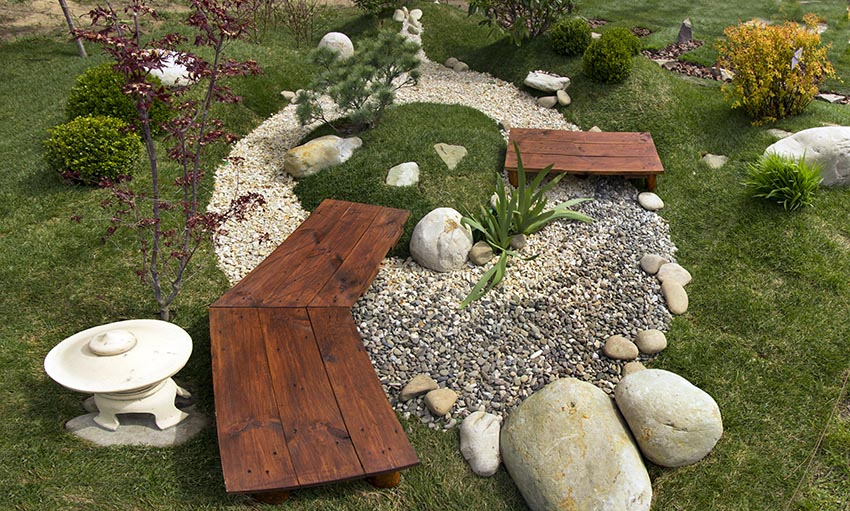
Two types of gravel pebbles make up this beautiful Japanese rock garden, complete with wood walkways leading to a grass island.
Pea Stone Gravel Border
A pea gravel border is an edging material placed around the perimeter of the gravel patio. Its main purpose is to contain the stones in one place. Aside from its function, a gravel patio border adds elegance and aesthetic appeal to your patio by defining it. Some of the edging materials which can be used as a gravel patio order are bricks, stones, cobblestones, flagstones, metal, galvanized steel, plastic, bender board, cedar or pressure-treated wood. These items can be sourced from local home improvement stores.
In choosing a material for your pea-pebble patio border, remember to choose something that is a good quality. Please do not skimp on the edging material as it will last longer.
Gravel may be used to cover large areas of backyard spaces to give them a more natural feel. Limestone pavers can be used as a walkway and as flooring material for the outdoor living space. The warm earthy color of the stones used complements the Rustic theme of a paver and pea gravel patio.
Regarding the size of the pea gravel patio border, its height must exceed the depth of your patio excavation. It is typically ½ inch higher than your dug out area but this dimension is adjustable according to your preference.
Pea Shingle Cost
The material cost of pea gravel is usually inexpensive and varies depending on the size of the project. Pea gravel usually costs around $300 to $400 for small projects for a 200 square foot coverage. Since small projects have small material requirements, pea gravel can be sourced from local home improvement stores. Purchase gravel in bags of 0.5 cubic feet at approximately $4 to $6 per bag for the plain stones and $8 for the colored variant. However, this cost still varies depending on the location and local service available.
For larger projects, pea gravel must be purchased from a landscaper or a gravel and stone supplier at tons or cubic yards. Plain pea gravel costs around $30 to $35 per cubic yard or $40 to $45 per ton. If you prefer the colored variety, consider an additional amount of $20 to $50 to your cost. Buying in bulk can save you more because the price can go as low as $15 to $20 per ton for a minimum quantity of 10 tons. You can avail of wholesale from gravel distributors if you have this amount of material requirement.
In terms of installation, a pea gravel patio can cost around $5 per square foot, including the base rock. The bigger the project is, the more expenses you would incur.
Some additional questions that affect the cost of a pea gravel patio are:
Style or type of stone – The least expensive kind of pea gravel is those with solid colors. As mentioned earlier, choosing a colored type of stone would cost more. Rounded and more polished stone products are also more expensive.
Depth of the pea gravel patio – The depth of the pea gravel patio naturally affects the amount of stone you will be needing to cover it.
The deeper, the higher the cost. A 1 inch of pea gravel is enough for patios that will only be used as walkways. A depth of 2 inches to 4 inches is required for gardens with plants while 6 inches is needed for patios with furniture.
Border or edging material – Edging around a pebble patio is necessary to keep it in place. Wood edging material usually costs $5 per linear meter, and metal edging material usually costs $6 per linear meter.
Labor – Installing a pea gravel patio by yourself can save you a reasonable amount of money, however, if your choose to a hire professional landscaper to do the work, consider an additional amount of $13 to $65 per hour in labor costs. Laying down gravel usually takes 2 hours to complete or more.
Delivery charges – Some suppliers offer free delivery for bulk orders of 10 to 20 tons. Delivery charges depend on the distance; ask your supplier so you can allot a specific budget for this.

Ways to Create a Gravel Patio
There are different ways to create a pea pebble patio. Because of the versatility of pea gravel, it can be mixed with any other stones or landscaping material to produce a patio design that suits your taste. The majority of these gravel patio variations require a level foundation and uses the “dry laying” method. Below are the common types of pea gravel patios:
Gravel and Epoxy Patio
Pea gravel epoxy patio, as the name suggests, is composed of 2 materials: pea gravel and epoxy. Epoxy acts a binding agent to keep the stones smooth and leveled for the patio. When these two materials are mixed, it creates a durable flooring material that can cater to high traffic areas. This type of patio is also a quick and easy job to do. Installing a pea gravel epoxy patio is basically just mixing gravel with epoxy and spreading it.
Crushed Gravel
Crushed gravel patio is composed of crushed stones or a type of construction aggregate which is usually 1 ½ inches to 2 ½ inches in diameter. Crushed stones are produced by breaking down a specific rock such as granite, limestone, marble or trap rock into a desired size. Crushed rocks such as white marble chips are perfect for Classic inspired gardens.
Crushed gravel is usually used as a reliable foundation rock base because it can be compacted and support outdoor furniture’s weight. Aside from this, it also works as a perfect ground cover for patios because of the natural and organic look it gives to a space. It is also affordable and easy to maintain. Just like pea pebble patios, crushed gravel patios are easy to install by just spreading the stones across the surface. A crushed gravel patio sitting area with metal outdoor chairs can be placed surrounding a large bowl fire pit with flowering plants elevating the property into an inviting oasis.
Concrete paving step-stones can be placed to lead through this pebble backyard landscape to a park bench for a pleasant spot for taking in the serenity of the garden. When designing a backyard, taking images from different views can help inspire you to think about the space in different ways.
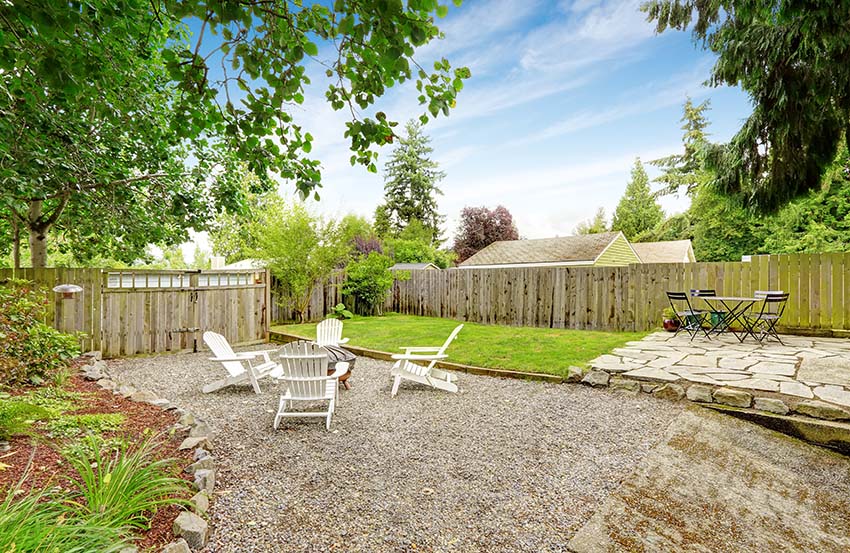
This simple DIY backyard features a loose aggregate area with Adirondack chairs and a border of large irregular cut rocks. There is a second sitting area made of concrete blocks with an outdoor dining set.
Paver and Gravel
Pavers are cut flagstones in irregular or square units. Paver and gravel patios are a combination of stone pavers arranged in a specific pattern and small pebbles which are used to fill in the gaps between – think of pea gravel acting as a grout for the pavers. Paver and gravel are a durable and affordable treatment for patios. Also, the combination of the two materials give endless design possibilities because of the diverse size, color and shape pavers have.
Installing a paver and gravel patio uses the dry set method wherein the pavers are dry set with sand on a rock and sand base and pea gravel is spread all throughout to fill the spaces between.
Flagstone and Gravel
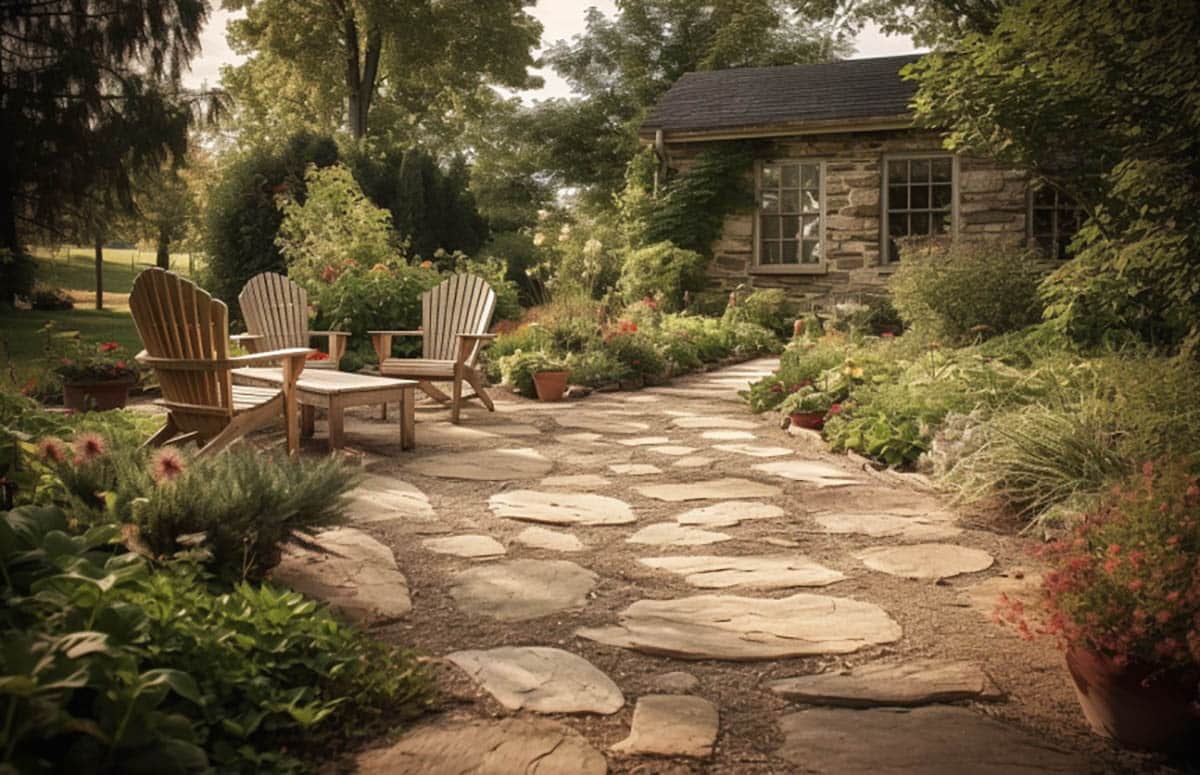
A flagstone is a flat stone slab of slate, sandstone, or limestone which is rectangular or square shaped used for paving. It is a preferred material for patios because of its narrow-packed joints. Flagstones come in various colors such as gray, brown, reddish or blue. It usually costs around $15 to $30 per square foot.
Flagstone and pea gravel patios are constructed by dry laid method wherein the large stones are set in a bed of sand or pea gravel. The recommended depth for this is 3 inches. The excavated area for the patio is filled with coarse sand and aggregates then flagstones are placed in a specific pattern. The joints are filled with the specific gravel of choice or sometimes mortared or planted with grass.
Flagstone and gravel patios have a natural and organic look and work for both informal and formal design styles. If you are aiming for a casual patio setting, use irregularly shaped flagstones and arrange them in a random pattern. If leaning towards a more formal vibe for your patio, lay rectangular flagstones in a uniform pattern.
Slate and Gravel
Slate is a fine grained greenish, blue, gray rock. It is usually sold for $18 to $30 per square foot. Though it costs up to three times more than other paving materials, slate still remains well loved by landscapers and homeowners because it is natural looking, durable and resilient.
Irregularly shaped slate gives patios and garden an interesting and eclectic touch. The combination of slate and rock works perfectly for Mediterranean inspired homes and gardens by giving them a rustic flair. Just like majority of pebbled patio types, slate and pebble patios use the same dry laying method wherein the slate pieces are arranged in a particular pattern and filled with pea sized gravel in between the joints.
During installation, it is ideal to start at a corner while keeping the gaps at a minimum. When the slate is completely set in a foundation base material, tamp each piece with a mallet and pour sand to fill the gaps then add grave as topper.
Brick and Gravel
Bricks function as edging material and border to define space. Bricks are typically small sun-dried rectangular blocks which are made up of clay. It is commonly used as building material for walls and walkways. Brick can be laid close together while pavers on the other hand interlock together and are available in a variety of shapes and sizes.
The brick and pebble patio is an casual and informal treatment for backyards and outdoor living spaces. It does not follow precise cutting and has a free form approach to design. When it comes to installation, this type of patio follows the same steps as the “paver and gravel patio”, “slate and gravel patio” and the “flagstone and pebble patio”. It uses the dry laying method wherein the bricks are set into a bed of compact sand and the cracks are filled with pea gravel. Brick and aggregate patios are perfect for adding warmth to a space because of its reddish color and texture.
Gravel Around the Fire Pit

If you want to utilize your backyard for a grill-out or to catch warmth during cold seasons then you may add a fire pit to your pebble courtyard. Usually circular in shape and made up of stones, the fire pit acts as the central feature of the patio. A fire pit is pretty easy to install. Interlocking pieces of stones make it together to form a round shape. An adequate height is usually 3 to 4 levels or full courses of stones joined by an adhesive or mortar. Then pea pebbles are added as a topper for the whole ground surrounding the fire pit.
Raised Gravel Design
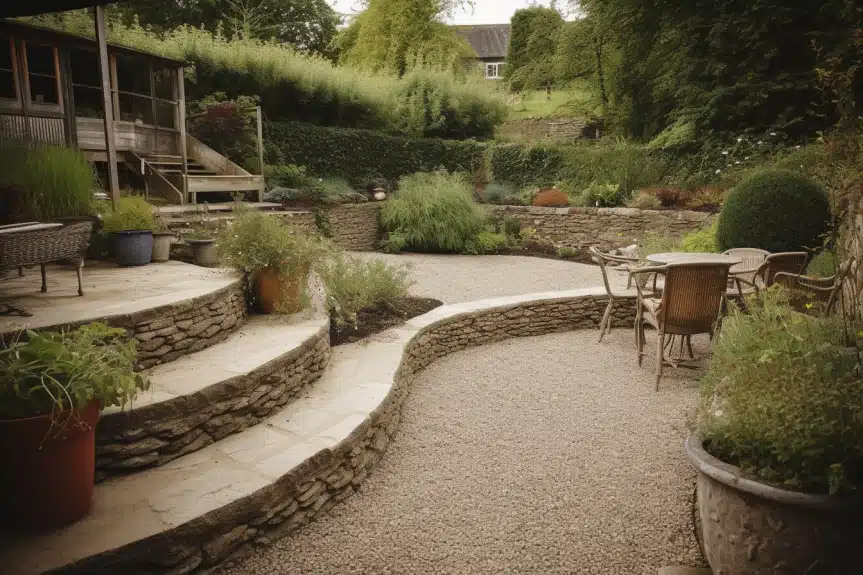
A raised pebble terrace is an outdoor space raised from the surrounding ground or built at a higher level than the existing ground. Installation-wise, it follows the same steps for building a pea aggregate courtyard but with an additional step of building a retaining wall. The retaining wall is built along the perimeter of the patio and serves as the border for the gravel. It may be bricks, wood or any material as long as it can act as a platform for the patio and a barrier for the small pieces of stones filling the base of the patio flooring.
This type of patio requires more filling materials and is usually 4 to 9 inches in height. It can be used if you want your patio floor to be the same level as your house’s floor or if you simply want to add dimension and elevation to your outdoor space.
How to Make a DIY Gravel Style Patio
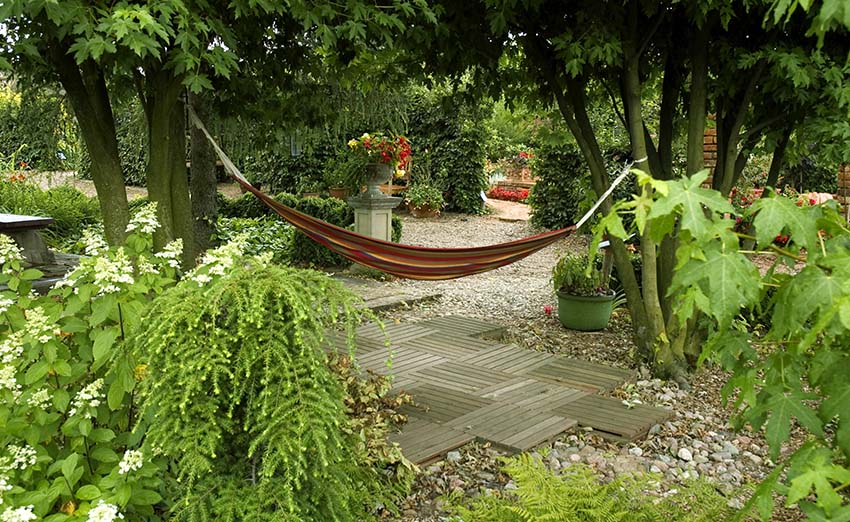
Compared to stones, interlocking bricks, or a wooden deck, a pebble terrace requires less effort when installing. It can be an easy “Do It Yourself” project since it does not require special skills or any technical knowledge.
Materials:
- Pea sized Aggregates (or any size of gravel you want; the amount will depend on size)
- Landscape Fabric
- Crushed stone (or any foundation base)
- Edging material (may be stone, metal, wood or plastic)
- Weed block rolls
- Grass killer
- Spray Paint
Tools Needed:
- Measuring tape
- Level
- Hoe
- Stakes (if needed)
- Shovel
- Small shovel
- Rake
- Wheelbarrow
Steps on Creating a DIY Crushed Stone Landscape for Your Home:
Plan out the size and shape of your patio. When it comes to design and shape, you can choose anything that fits your sense of style. This phase offers the freedom to exercise your creativity and gives you flexibility in forming the perfect concept for your patio. On the other hand, size will greatly depend on your backyard’s existing conditions and other factors.
The amount of space you need for your pebble courtyard will greatly depend on the purpose you intend to use it for. Determine the activities you will be doing here, the number of users in the area, and how you want to furnish it. Small spaces are appropriate for bistro style patio set up which contains at least 2 chairs and a table.
Large spaces, on the other hand, can accommodate more furniture and design elements. Sometimes,it may be designed as an outdoor living area complete with a fire pit. Just remember that if you plan on putting an informal backyard dining area or an outdoor living room space, consider the sizes of furniture you will be using.
For example, a patio which is 12 to 14 feet in size can accommodate a 48 inch table which can seat around 6 to 8 persons depending on the chair size. Also keep in mind that the size must also balance out with the surrounding environment. Consider proportion and make sure that shape blends well with the landscape.
Plot the shape of your patio in the yard – Measure the existing space with a measuring tape and plot your desired shape and size onto the grass using spray paint. You may use other materials to mark the space.
Determine the depth of gravel – Once the purpose for the patio is decided, you can know also determine the depth of your pebble terrace. The depth of pebbles for a patio usually ranges from 1 inch to 4 inches. Typically a standard depth of 2 inches is sufficient, but this changes depending on the existing conditions of the ground soil.
If the soil is not firm, digging deeper is necessary. The type of base or foundation to be used will also determine the depth of the hole you need for your pebble courtyard. If using soil for the base, dig 2 inches deep but if adding stone for the base, dig a 4 to 4 ½ inches deep hole.
Add up the amount of aggregates needed to cover the patio – The cubic yard needs to be determined to know the amount of pebble needed to cover a patio. First, get the total area of your patio in square feet by multiplying the length and width of the space (in inches). Divide the total area by 12 to get the cubic inch in volume. Multiply the resulting number by the number of inches you want for the gravel’s thickness.
Since the amount of coverage of pebble needs to be in the unit of measurement of cubic yards, convert the resulting total by simply dividing it by 27. Round this off to the nearest whole number to get an estimate of the amount of pebble you need for coverage. There are also aggregate calculators available online which can help you compute your material requirements instantly.
Prepare the area. Clean the area by removing weeds and spraying with grass killer if needed. Remove obstructions or debris such as roots, sticks, rocks, etc.
Excavate the area. Dig the area for the desired depth. As you excavate the ground, evaluate the condition, texture and consistency of the soil. Level the dirt and make sure that the soil is tamped down. Use a hoe or shovel to compact the soil at the bottom of your excavated area. Whether using you’re using the soil or crushed stone as your base, it is important to not skip this step.
Add the edging or border along the perimeter. Choose a type of edging material for your pebble courtyard to contain the pebbles in one place. For example, if using wood as a pebble barrier, cut pieces of 2×2 lumber according to the shape and size of your patio. Lay out wood and connect corners or ends by screwing brackets. The adhesive may also be used to join wood pieces together easily and conveniently. Let the joined edging pieces dry and ensure they are tightly secured.
Add the base or foundation layer. Soil that is densely packed and has clay like consistency does not need an additional stone base layer. But for loose or sandy soil, add crushed stones to keep the pebble in place. Rough textured rocks work best as stabilizers for a pebble courtyard.
Before laying the gravel, put landscape fabric on top of the foundation base. The landscaping fabric acts as a landscape barrier that separates the dirt and the gravel. It also aids in preventing weed growth and keeps rodents from digging through the ground.
Add pea gravel to your patio. Pour 2 inches of pea aggregate and spread evenly. Leave ½ inch space between the pebble and the edging to prevent the small stones from spilling.
Level out with a rake. Take time to smooth and even out the surface of the pea aggregate open air space by raking. This also compacts it so that the loose pebble stays in place.
Some other things to keep in mind in installing a pebble patio:
If using outdoor furniture for your patio, provide a firm foundation. Add at least 6” inches of thick rock base layer to support your furniture. These additional elements in your patio design will naturally cause appropriate changes in the depth of soil you need to dig and the amount of aggregate you need to purchase. Maintaining a pea aggregate open air space would require occasional raking to even our the surface. Replenish your pebble terrace every 3 to 4 years.
Stone pavers may be set in unique patterns like those shown in this Pinterest-perfect design. There is really no limit when it comes to designing your pea-pebble courtyard. Use it as an interesting focal point for your landscape.
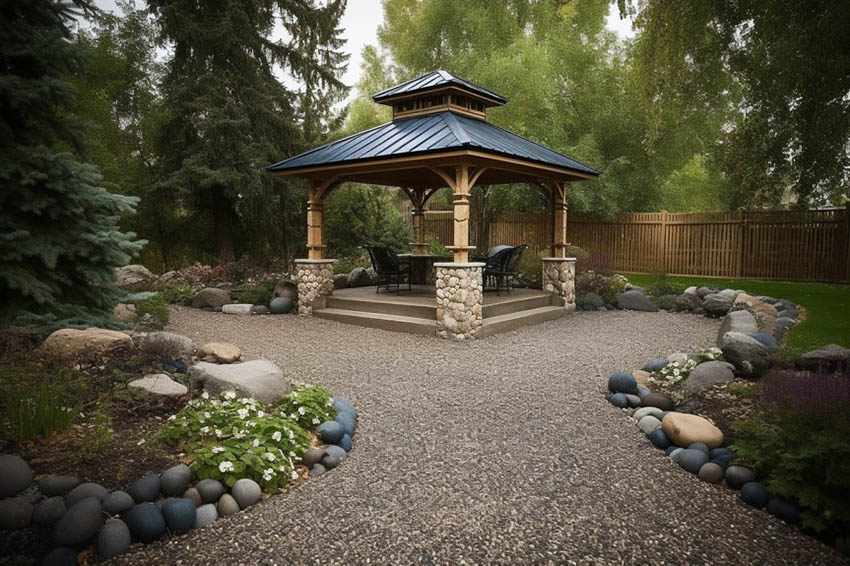
This backyard gazebo with outdoor furniture is surrounded by pea pebbles with a smooth stone border. Raised flower beds are used to add visual interest and contrast to the home’s design. A large lawn backs up to the area fencing and gives a backdrop of color in contrast to the color of the stones.
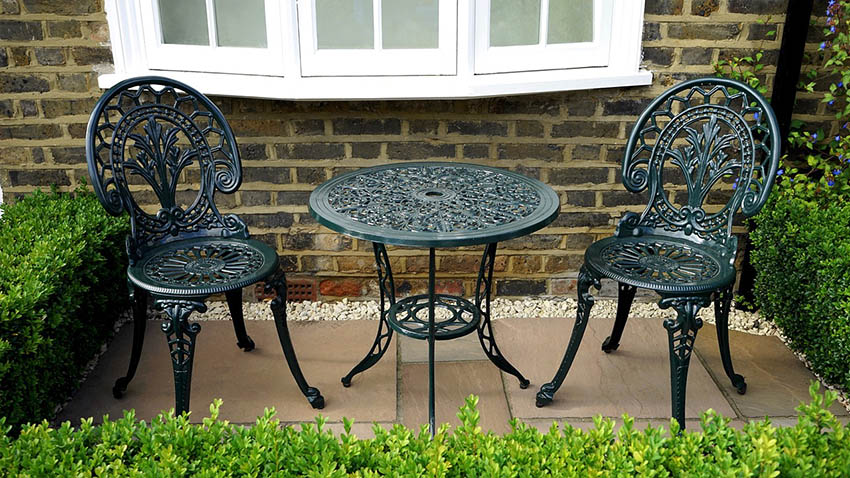
This small cozy patio features square stone slabs with a border or white gravel. A rustic wrought iron furniture set makes this a great spot to enjoy morning coffee or to relax after a long day.

A cozy rustic place for gathering with friends or family, this pebble courtyard design made use of large irregular rocks for the fire pit and small gray pea pebble for the flooring. The seating area blends well with the surrounding landscape by using a stone ledge and some accent pillows.
Related Patio Ideas You May Like:
Beautiful Patio Ideas – Stone Patio Ideas – Paving Stone Ideas

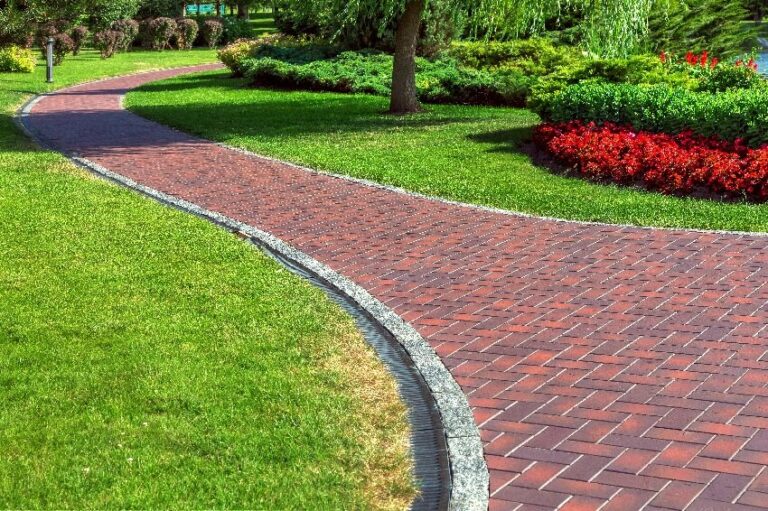
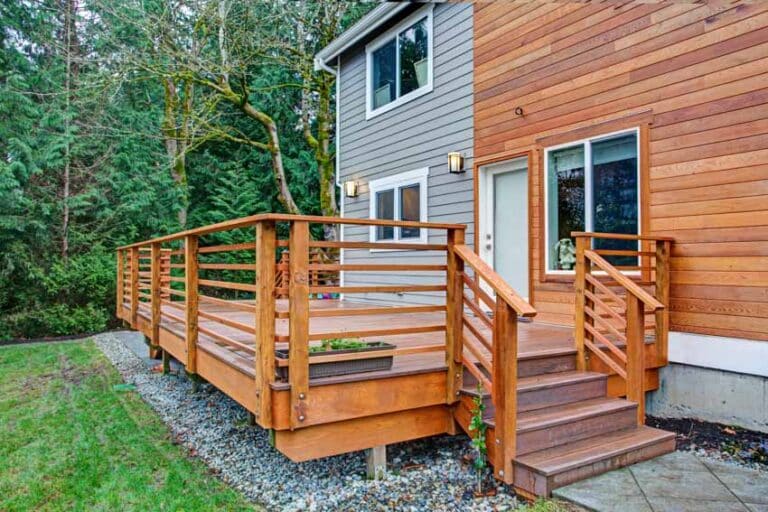
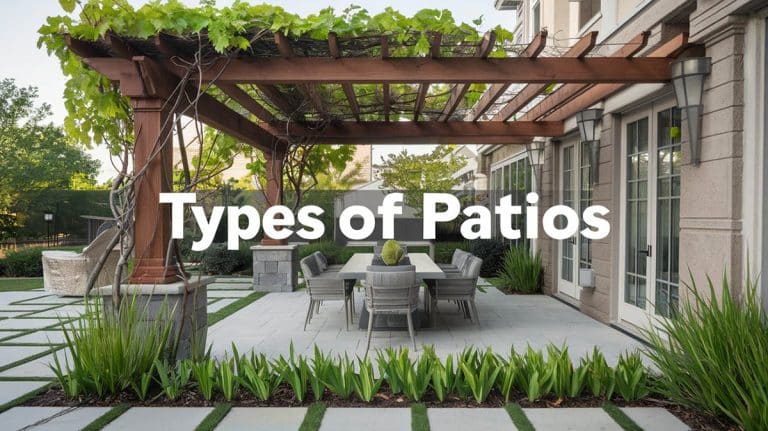

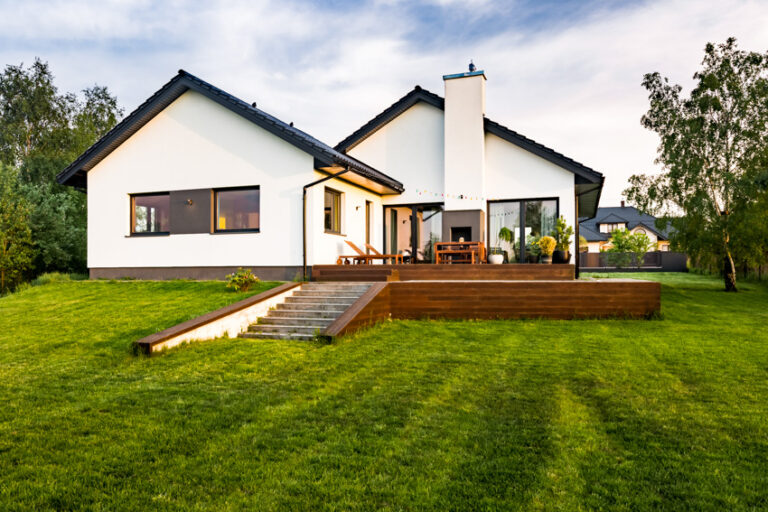

I love the photo you shared that uses flagstone and gravel to create a patio for a jacuzzi. My husband and I really like the idea of using gravel in the landscape design for our new home for a modern feel. Thanks for giving me these other ideas we can incorporate after we have the gravel delivered and in place!